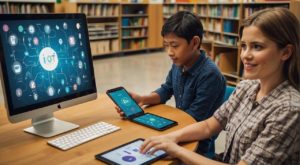

Imagine students exploring the vastness of space from their classrooms or dissecting a virtual frog with the swipe of a finger. VR technology has unlocked limitless possibilities for interactive learning, transcending traditional textbooks and lectures. By immersing students in realistic simulations, we can foster curiosity, engagement, and deeper understanding across various subjects.
Check out this XReady Lab video about virtual STEM eduverse.
Virtual reality allows for safe experimentation and exploration of scenarios that are impossible in real life. From traveling through space and back in time to studying marine life underwater and handling dangerous biological samples, VR makes everything possible.
We should also discuss the potential of XR in education—a concept that combines virtual, augmented, and mixed reality. Augmented reality (AR) overlays digital content onto the real world, while mixed reality (MR) combines virtual elements with the physical environment, enabling interactive simulations for hands-on learning, enhancing students’ engagement and comprehension.
AI-driven adaptive learning platforms are reshaping the educational landscape by catering to each student’s unique needs and learning pace. AI technology anticipates individual learning patterns, facilitating the creation of customized educational content aligned with each learner’s objectives and prior accomplishments. AI tools enable educators to personalize learning journeys according to students’ unique needs, preferences, and cognitive approaches.
Through intelligent algorithms, educators can track individual progress, identify areas for improvement, and deliver personalized content tailored to students’ strengths and weaknesses. This personalized approach not only enhances academic performance but also nurtures confidence and a love for learning.
Check out some Duolingo examples of personalizing learning through AI in the video.
The Internet of Things (IoT) refers to a vast interconnected network of physical objects embedded with sensors, software, and various technologies. These “things” gather and exchange data with other devices and systems via the Internet, enabling users to monitor and manage devices remotely.
IoT technology offers significant advantages for individualized education. By leveraging IoT devices, educational institutions can gather detailed insights into each student’s unique learning needs and progress. These insights enable educators to customize lessons and provide targeted support to enhance student success.

In addition to personalized learning, IoT devices, including sensors, cameras, and interactive whiteboards, are instrumental in creating smart classrooms. These devices facilitate the monitoring of classroom dynamics, student participation, and real-time feedback for both students and teachers. Wearable technologies like fitness trackers and smartwatches can capture data on students’ physical activity, sleep habits, and focus levels. This information helps tailor learning experiences and identify students needing additional assistance.
IoT-enabled sensors also facilitate hands-on experiments in science and engineering, providing students with tangible tools to explore complex concepts and develop problem-solving skills in a real-world context.
The concept of the “metaverse” is currently trending, often associated with gaming and entertainment. However, its scope extends far beyond that, encompassing areas like education.
The metaverse is a persistent virtual realm where individuals use avatars to engage with the environment and interact with one another in real time.
The Metaverse can enrich conventional educational methods with its array of virtual environments, platforms, and resources that enhance and elevate the delivery of educational content and interaction. It also fosters global cooperation and cultural exchange among learners and instructors, breaking geographical barriers and enabling collaboration, knowledge exchange, and insights from diverse cultural perspectives.
Check out our recent articles about a case study of a Japanese school that exists entirely in the metaverse, as well as an introductory article about metaverse teacher tools that you can start using with just a smartphone or computer.
LINK
LINK
At XReady Lab, our mission is to empower educators with innovative tools that ignite curiosity, spark creativity, and foster lifelong learning. Through our extensive library of VR STEM simulations, we aim to create a learning environment where students are not merely passive consumers of information but active participants in their educational journey.
Try our free demo of virtual reality STEM simulations:
As we continue to push the boundaries of educational technology, we invite educators and stakeholders to join us in revolutionizing K-12 education. Together, we can harness the transformative power of VR, AI, robotics, IoT, and collaborative tools to inspire the next generation of thinkers, innovators, and leaders!
You may like it
Frequently Asked
We prodive VR biology, VR physics, and VR chemistry simulations. Please, check our catalog.
Please, fill the form to get demo labs for free.
Please contact our customer support service at support@xreadylab.com or book a call with the team to find out the conditions and book the VR class set up at your school.
Subscription to XReady Lab interactive VR labs. If you are a school, then you are also given access to the VR classroom system. VR class system helps you easily launch VR lessons for a large number of students, follow the experience of each student, as well as customise the content without developers.
We adhere to the world’s generally accepted recommendations and research. Our products are suitable for children from 12 years old.